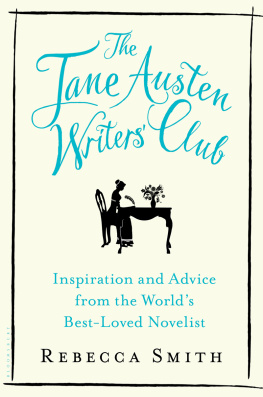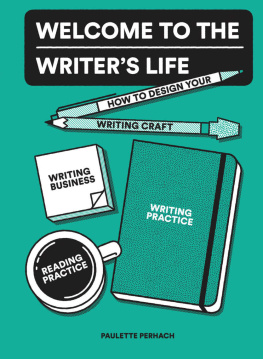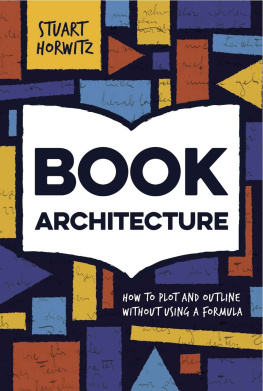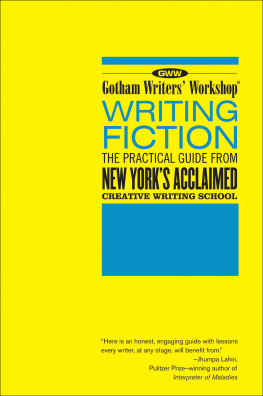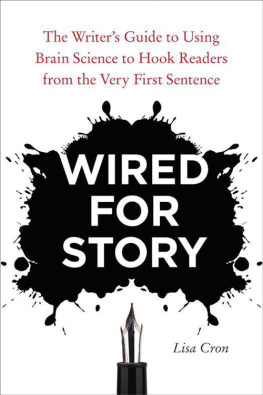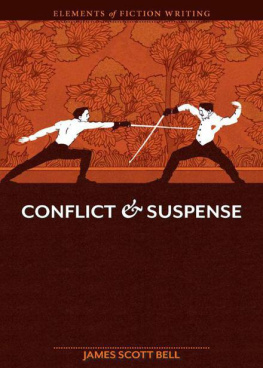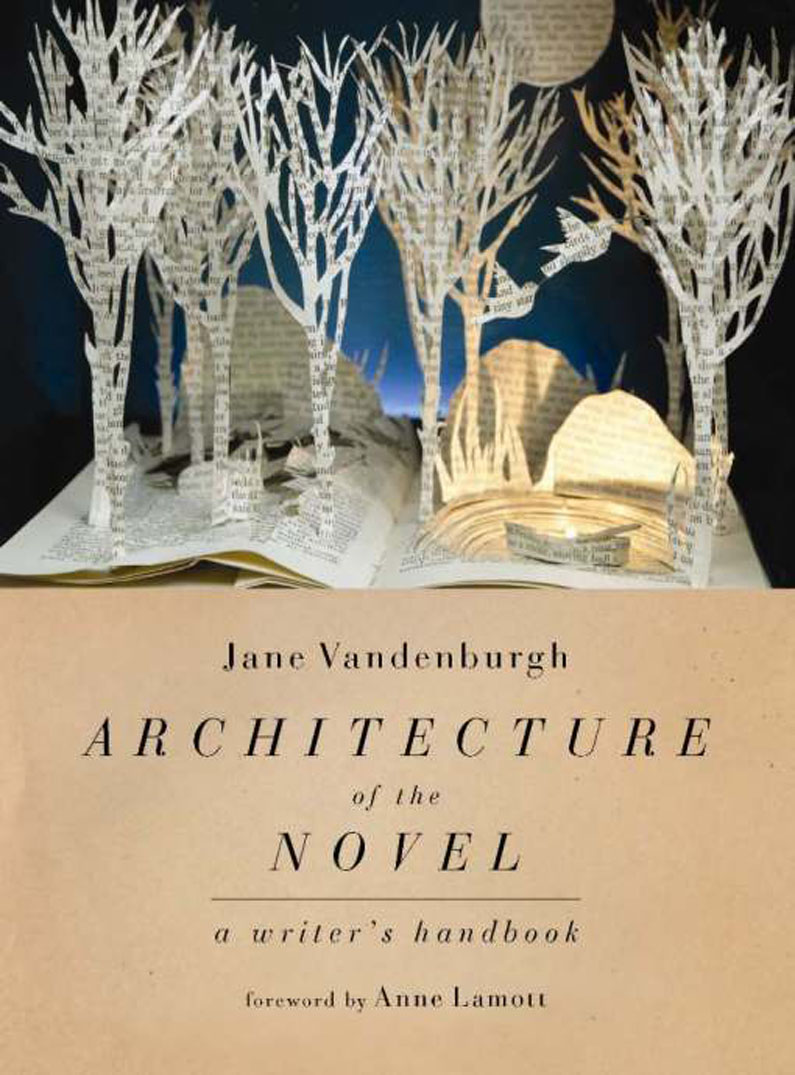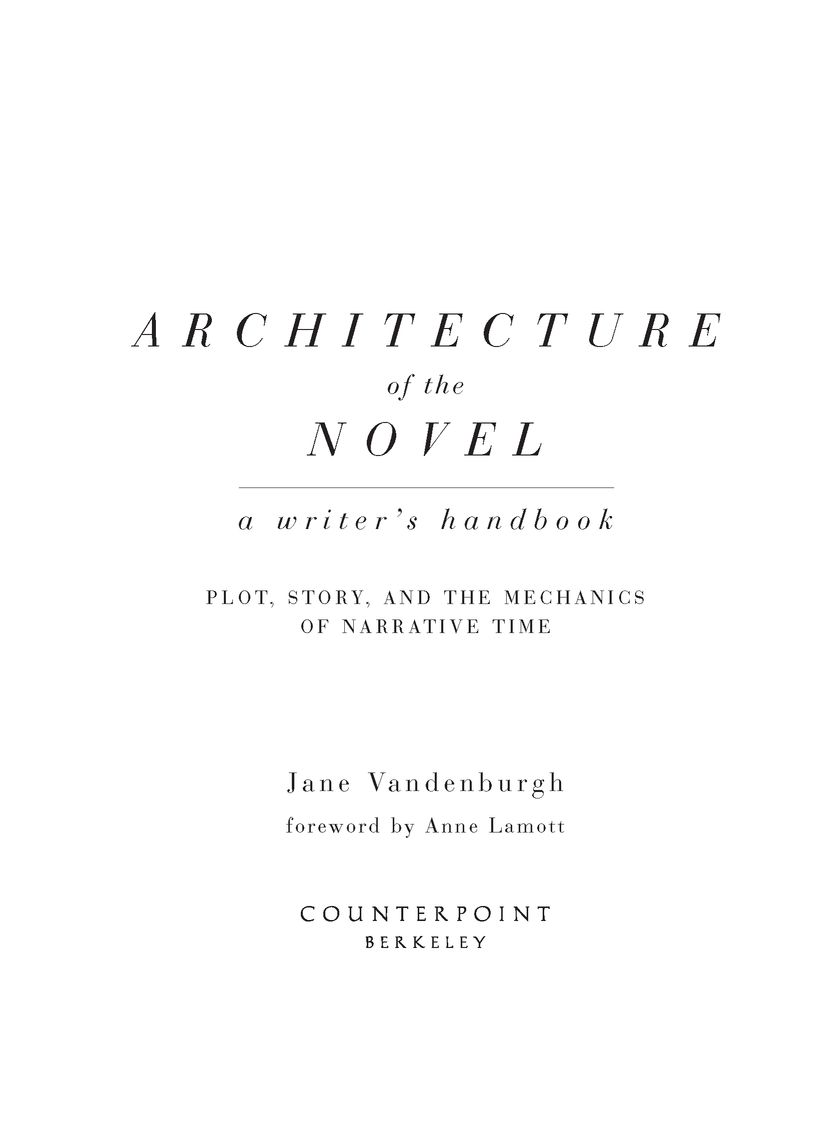Table of Contents
Guide
Table of Contents
OTHER BOOKS BY JANE VANDENBURGH
A Pocket History of Sex
in the Twentieth Century: A Memoir
The Physics of Sunset: A Novel
Failure to Zigzag: A Novel
The order of your book must proceed on this plan:
first simple beams, then those supported from below,
then suspended in part, then wholly suspended.
Then beams supporting other weights.
LEONARDO DA VINCI, THE NOTEBOOKS, 1452
FOREWORD
BY ANNE LAMOTT
ARCHITECTURE OF THE NOVEL is a book after my own heart, rich in paradoxes and yet wonderfully plain, with an insistence on structure and discipline. It is also a call to freedom. Its about how to write a novel, why you must write a novel, and why the time is now.
As with everything Jane Vandenburgh has written, Im amazed by her generous and ferocious mind, by the way she is able to edify and encourage and entertain, all on the same page. Im not sure who else could write about the mysteries of how we tell our stories with such vigor and intelligence, curiosity and insight. Her ability to clarify the wheres and hows of writing fiction, her instructions on where to begin, on how to listen as the story and its characters reveal themselves to us, how to soar as a novelist while keeping things simple and real, almost make me want to write another novel.
Because it is really hard, and it takes such rigorous commitment! Any writer who tells you differently is either lying or has missed the boat. But Architecture of the Novel reminds me of all the good news, too, that the story already exists inside us, that telling the story is worth it.
In her own novels, Jane Vandenburgh has written about life and people with directness and lyricism and hard-won humor. In her ability to articulate the great themes of our lives and literature, of time and loss, love and resurrection, she can be exhilarating, scary, calming and intense, all at once. Her mind and heart are those of a poet, but her passion has always been the narrative in its longer form.
How do we tap into our own sensitivity, our own wildness of spirit, while structuring our moments and scenes into something coherent, tangible, cohesive, something that can be heldas she puts itlike a glass of clear water. Here you find the words of someone who has been sharing these secrets for a long time, of how to create a narrative, how to discover and be true to our characters, how to tough it out when it gets hard. She knows how easy it is to give up, how difficult it sometimes is to find your own voice, how necessary bad writing is, how bad writing leads to better writing if only you will let it, maybe even something close to what we had in mind all along. She knows a lot about truth and survival and the brokenness we all share, and man, she knows a lot about writing.
All of her books, and this one in particular, remind me of physical things I love. One is a nearby boulder that I visit fairly often, at American Soil in Marin County where I livethis rock is everything wonderful and grave and heavy and weightless and lovely all at once.
It weighs in at over a ton and it is the platonic essence of ROCK, slate gray and brown and craggy, but also curvaceous and ribboned with broad streams of rose quartz, which is all about love. It is tiled with moss green lichen, soft as fur or feathers, and on its top floorthe penthouse of this rockare all sorts of little caverns and cavities and cracks and openings that create ponds of water, and gardens that hold tiny curly richly alive and brilliant green plants and shoots; and if you are the kind of person willing to pay attention, youll meet teeny little creatures, hilarious and heartbreaking. You could stare at it and listen to it for hours, and youll want to hold it, and share it with everyone you know.
This book in your hands contains what you need to get your novel writtenand to discover the truth of who you are. It sort of tricks you into insisting on telling the truth, with your own voice and experiences and rhythms, even though if you are anything like me, her writing always makes me want to sound more like her. Her heart is strong and it is equally soft, as is yours. She is exotic and plain and down to earth, like you and maybe most of your favorite writers, and she shows you in this book how you can access and hone the gift of successfully telling the story that is yours alone to create.
Jane is brilliant, lovely, difficult, dark, aglow, and dangerous, rascally and sad, hilarious, spontaneous and talkative, with deep curiosity and lots of attitude. She might and almost certainly will say anything that crosses her mind. Maybe you have always dreamt that one day you, too, might capture your own version of this, on paper, both to help you figure out what your version even is, and in order to give it away.
That day is now, and I present a blueprint of how to make that happen. But be careful. This book is going to ruin your excuses, and your tendency to procrastinate. Its going to make it possible for you to redeem earlier senses of failure and you from your foolishness in thinking you could ever become a novelist.
And the second physical thing Architecture reminds me of is my favorite album from thirty... plus... years ago, when I was a very young writer. The record was called Eat a Peach, by the Allman Brothers, recorded live at the Fillmore East. Theres a thirty-three-minute jam session with Gregg Allman, Dickey Betts, Berry Oakley, Butch Trucks, Jai Johanson; but mostly its the last recorded slide guitar by late and very great Duane Allman, who died before the album was even issued. This one track took the Donovan Leitch song There Is a Mountain, which goes, First there is a mountain, then there is no mountain... then there is, which, if you think about it, pretty much says it all, and these guys played it with such aching greatness and passion (and maybe stonedness) and confidence and edge and sexuality that it was almost devastatingbut instead its one of the most beautiful rock and blues pieces in history. And it all springs from a simple tune, something you might sing to a child.
After establishing the melodyand only because of its careful establishmentDuane Allman started playing passages that took you so far out there that you couldnt imagine how he could possibly bring you back home. But because of the clarity of his guitars voice, you heard something right away that had a crystalline energy to it, the ring of truth, that is really all that ever totally hooks us. As with a novel you love, you had to keep listening to it, had to keep turning the pages. And because you hung in there, and because he stayed so true to what was in his heart and mind, the song took you to the moon, and to the inner reaches of the human experience, and it made you want to cry and dance and shout, and it made you kind of crazy, in the freedom way, even as it somehow comforted you. Then it slowly, luxuriously, brought you back home. Only of course you werent the same person youd been before youd taken the journey, or you were, but maybe more so, and which is the greatness of art.
I wouldnt read this book unless you are serious about wanting to try and do that, too, to find your way through the stories within, listening for the melody, trusting in the structure while finding your wings, and living the life of a writer.


